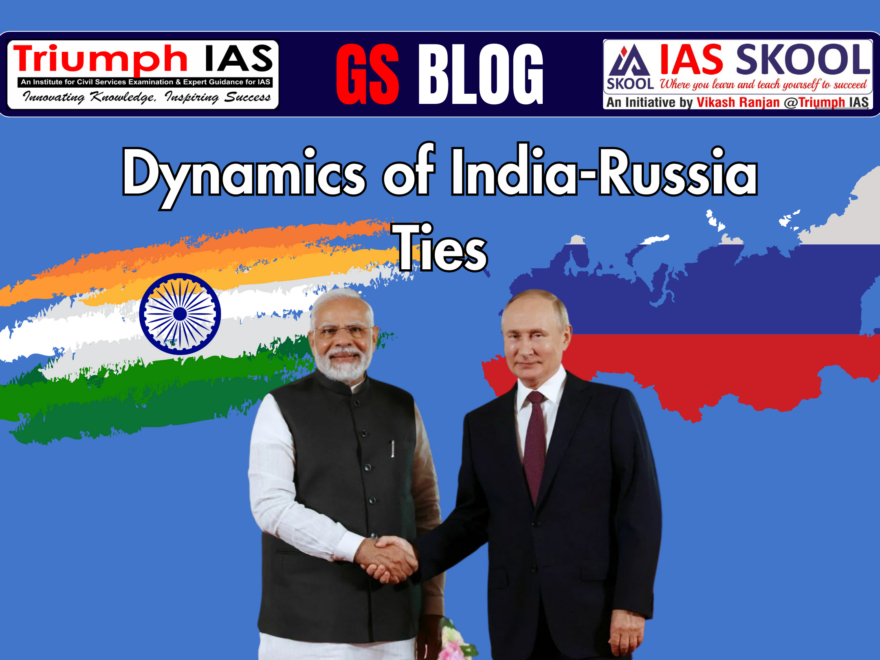Dynamics of India-Russia Ties
The India-Russia relationship stands out as one of the most significant bilateral partnerships in global diplomacy, extending beyond strategic cooperation. Russia continues to be India’s most reliable partner in advanced defence technologies and energy supplies. This partnership allows India to counterbalance Russia’s tilt toward China, stabilize global energy markets, and uphold a balanced perspective in emerging power blocs like BRICS. However, India faces the challenge of maintaining this relationship while managing its growing ties with Western nations. To navigate these complexities, India must actively preserve its strategic autonomy and strengthen this crucial partnership amidst evolving global dynamics.
Background of India –Russia ties
Cold War Solidarity (1950–1991):
- The Soviet Union supported India on critical issues like Kashmir and Goa’s liberation, emphasizing shared strategic interests.
- The 1971 Treaty of Peace, Friendship, and Cooperation was instrumental during the Bangladesh Liberation War, strengthening bilateral ties.
Post-Soviet Adjustment (1991–2000):
- After the dissolution of the Soviet Union, India and Russia redefined their relationship to maintain strong defense and strategic cooperation.
Strategic Partnerships:
- 2000: The Strategic Partnership Declaration formalized collaboration across various sectors.
- 2010: The relationship was upgraded to a Special and Privileged Strategic Partnership, highlighting its exceptional significance.
Trade Expansion (Recent):
- Bilateral trade reached a record $65.7 billion in FY 2023–24, with India’s exports rising by 42.7% and imports declining by 39.9%, indicating reduced reliance on Russian oil.
- India’s key exports to Russia: Pharmaceuticals, organic chemicals, and machinery.
- India’s major imports from Russia: Oil, fertilizers, and minerals.
- In October 2024, the two nations held their first working group meeting on the Northern Sea Route, marking new areas of collaboration.
Current Status of India-Russia Relations in a Changing Global Order
Strategic Autonomy Amid Geopolitical Rivalries:
- India’s relationship with Russia demonstrates its commitment to strategic autonomy, allowing New Delhi to foster diverse partnerships without aligning with any particular bloc.
- Despite Western sanctions on Russia, India has strengthened its energy and defense ties while maintaining robust relations with the US and the EU.
- During the Indian Prime Minister’s visit to Moscow in July 2024, the two nations reaffirmed their Special and Privileged Strategic Partnership, with plans to significantly boost bilateral trade by 2030.
Energy Security as a Cornerstone:
- India has capitalized on Russia’s pivot to Asia to ensure affordable and reliable energy supplies.
- European sanctions on Russian imports enabled India to secure energy resources at reduced prices, shielding it from global oil price volatility.
- Russian oil now constitutes 35% of India’s total crude imports, while bilateral trade reached $65.7 billion in FY 2023–24, underscoring pragmatic economic cooperation.
- Russian assistance in projects like the Kudankulam Nuclear Power Plant remains vital, while Indian investments in Russian oil fields, such as Sakhalin and Tomsk, ensure steady energy access.
Defense Cooperation – From Buyer to Co-Developer:
- The India-Russia defence partnership has evolved from mere procurement to co-development, bolstering India’s indigenous capabilities and strategic autonomy.
- Programs like the BrahMos missiles and Su-30 MKI production exemplify this transition.
- Despite diversification to suppliers like France and Israel, Russia still accounts for 45% of India’s defence imports.
- In 2024, the two nations expanded the Make in India initiative to include the joint production of high-speed electric trains for Indian Railways.
Economic Diversification Beyond Energy:
- India and Russia are broadening economic ties to focus on technology, agriculture, and manufacturing, reducing dependence on oil.
- The Rupee-Ruble trade mechanism and Free Trade Agreement (FTA) negotiations with the Eurasian Economic Union (EAEU) highlight this diversification.
- India’s exports to Russia grew by 42.7% in 2024, driven primarily by pharmaceuticals and machinery.
Connectivity to Reshape Global Trade:
- India-Russia connectivity initiatives, such as the International North-South Transport Corridor (INSTC) and the Chennai-Vladivostok Corridor, aim to bypass traditional maritime routes and reduce dependency on unstable chokepoints.
- These projects enhance logistical efficiency and cut shipping times.
- The INSTC reduces shipping time by 40%.
- The Chennai-Vladivostok Corridor reduces transit times from 40 to 24 days, significantly improving trade efficiency and boosting bilateral commerce.
Challenges India Faces in Navigating Relations with Russia
Balancing Ties with the West and Russia:
- India’s deepening ties with the US and EU, particularly through platforms like the Quad and ongoing trade negotiations with the EU and UK, create complexities in managing its relationship with Russia.
- Western nations pressure India to align with sanctions on Russia, which risks compromising India’s strategic autonomy.
- Despite criticism, Russia was India’s largest oil supplier in 2023. While the US expressed concerns over India’s significant Russian energy imports, it clarified that no “red lines” would be imposed, though warnings of potential “consequences” were issued.
Managing the Trade Deficit:
- India faces a significant trade imbalance with Russia, as imports—mainly oil and fertilizers—far exceed exports. Limited diversification of exports exacerbates this issue.
- In FY 2023–24, India’s exports to Russia amounted to $4.26 billion, while imports reached $61.44 billion, leaving a trade deficit of $57.18 billion.
- While pharmaceutical exports grew by 42.7%, they remain insufficient to significantly reduce the gap.
Financial and Logistical Challenges:
- Western sanctions on Russia have made financial transactions, investments, and logistics for India-Russia trade more difficult, increasing costs and uncertainty.
- The Rupee-Ruble trade mechanism has faced implementation issues, with limited adoption.
- Private banks, fearing secondary sanctions, are reluctant to adopt the Vostro account system, further delaying trade in local currencies.
Navigating Russia-China Proximity:
- Russia’s growing alignment with China, especially in Arctic and energy projects, creates strategic challenges for India.
- China’s expanding influence in Russia’s Far East impacts India’s connectivity goals. For example, while India has operationalized the Chennai-Vladivostok Corridor, China’s involvement in the Northern Sea Route risks reducing India’s access to this key region.
- In 2023, Russia-China trade surpassed $200 billion, with significant investments in Arctic projects, underscoring their deepening ties.
Multilateral Pressure and Abstinence from Voting:
- India’s neutral stance on global crises, such as the Ukraine conflict, contrasts with the expectations of multilateral institutions like the UN Security Council, straining its diplomatic balancing act.
- In July 2024, India abstained from a UN resolution demanding Russia cease aggression against Ukraine and withdraw from the Zaporizhzhia nuclear plant, polarizing its diplomatic engagements.
- At the 2024 G20 Summit, India maintained neutrality and refrained from outrightly condemning Russia, underscoring its non-aligned position.
Geopolitical Uncertainty in Central Asia:
- India’s strategic initiatives, such as the International North-South Transport Corridor (INSTC), rely on stable connectivity through Central Asia, a region increasingly influenced by China.
- Political instability in Central Asian countries complicates India’s efforts to enhance trade and connectivity.
- For instance, INSTC trade volumes have faced delays due to Iran’s internal disruptions and geopolitical tensions in Kazakhstan, a key transit country for the corridor

Measures India Can Adopt to Balance Ties with Russia Amid a Disrupted Global Order
- Diversify Economic Engagement Beyond Energy:
- India should broaden its trade portfolio with Russia, moving beyond oil and defense to include sectors like technology, pharmaceuticals, and agriculture.
- Accelerating the India-Eurasian Economic Union (EAEU) Free Trade Agreement and incentivizing private-sector participation can unlock new opportunities for non-energy trade.
- Sectors such as machinery and chemicals hold significant potential for growth under improved trade mechanisms.
- Enhance Defence Co-Development Under Make in India:
- Transitioning from defense procurement to co-development with Russia can strengthen India’s indigenous defense manufacturing capabilities.
- Joint ventures that ensure technology transfer and focus on co-production will reduce dependency on imports and align with India’s aspirations of becoming a global defense hub.
- Expand Arctic Collaboration and Energy Security Initiatives:
- India should deepen its Arctic partnership with Russia by investing in energy exploration and leveraging the Northern Sea Route (NSR) for trade.
- Projects like LNG infrastructure development and polar navigation training can secure India’s long-term energy needs.
- The October 2024 Arctic Cooperation Working Group underscored India’s intent to utilize the NSR for importing energy, offering both strategic and economic advantages.
- Promote Cultural and Educational Exchanges:
- Strengthening cultural diplomacy and people-to-people ties can enhance long-term bilateral relations.
- Initiatives such as opening Indian cultural centers in Russia and encouraging Russian students to study in India will foster goodwill.
- The establishment of new consulates in Kazan and Ekaterinburg in 2024 provides a platform for expanding cultural and educational exchanges.
- Focus on Renewable Energy Collaboration:
- India should diversify its energy relationship with Russia by exploring joint ventures in renewable energy sectors like solar, wind, and hydrogen.
- Collaborating on green energy aligns with India’s transition to sustainable energy sources while maintaining its strategic energy partnership with Russia.
- India’s renewable energy sector, which is projected to attract $250 billion in investments, offers Russia opportunities for collaboration.
- Mitigate Trade Deficit Through Sector-Specific Strategies:
- Addressing the trade imbalance requires a focus on India’s competitive sectors, including IT services, textiles, and food processing.
- Establishing special economic zones (SEZs) in Russia for Indian exporters can help boost Indian exports.
- Navigate the Russia-China Dynamic with Strategic Diplomacy:
- India should tactically engage Russia to ensure its strategic interests are not undermined by Russia’s growing proximity to China.
- Offering alternative collaborations in areas like the Arctic, artificial intelligence, rare earth minerals, and space exploration can keep India relevant in Russia’s strategic calculus.
- Establish Joint Ventures in Fertilizer Production:
- India can invite Russian investments to set up fertilizer manufacturing plants domestically, reducing dependency on imports while leveraging Russia’s raw material expertise.
- Fertilizers accounted for $2.63 billion of India’s imports from Russia in 2023. Localizing production would lower costs and enhance India’s agricultural self-reliance.
- Enhance Cybersecurity and Digital Collaboration:
- With the growing importance of digital infrastructure, India can partner with Russia to develop robust cybersecurity frameworks, AI research, and data protection technologies.
- Russia’s expertise in cybersecurity complements India’s expanding digital economy, enabling mutually beneficial collaborations.
- Foster Strategic Tourism Alliances:
- Promoting bilateral tourism through exclusive travel packages, joint cultural festivals, and simplified visa processes can strengthen people-to-people ties.
- Expanding direct air routes and running targeted tourism marketing campaigns will further boost tourism between the two nations.
- Build Academic Research Hubs Focused on Eurasian Studies:
- Establishing research hubs dedicated to Eurasian politics, culture, and economics can guide Indian policymakers and businesses in navigating relations with Russia and its neighbors.
- Collaborations between Indian institutions like Jawaharlal Nehru University and Russian universities can foster scholarly exchanges, deepening mutual understanding.
The India-Russia relationship remains a cornerstone of India’s strategic foreign policy in a rapidly evolving global order. This partnership continues to flourish in key areas such as defense, energy, and multilateral diplomacy. However, challenges like trade imbalances, logistical barriers, and Russia’s closer alignment with China necessitate a nuanced approach. By expanding economic engagement, improving connectivity, and fostering joint ventures in emerging sectors, India can strengthen its ties with Russia, ensuring the partnership remains resilient and contributes effectively to global diplomacy.
The End of the Blog: Dynamics of India-Russia Ties

|


















